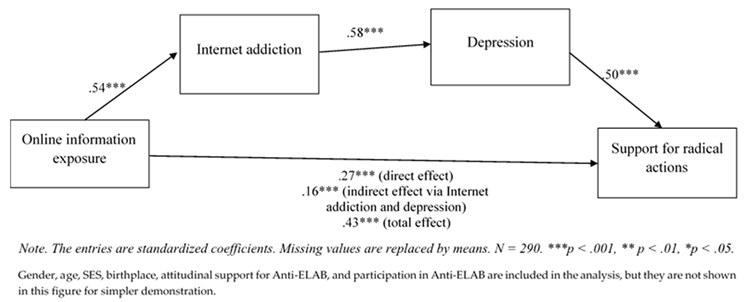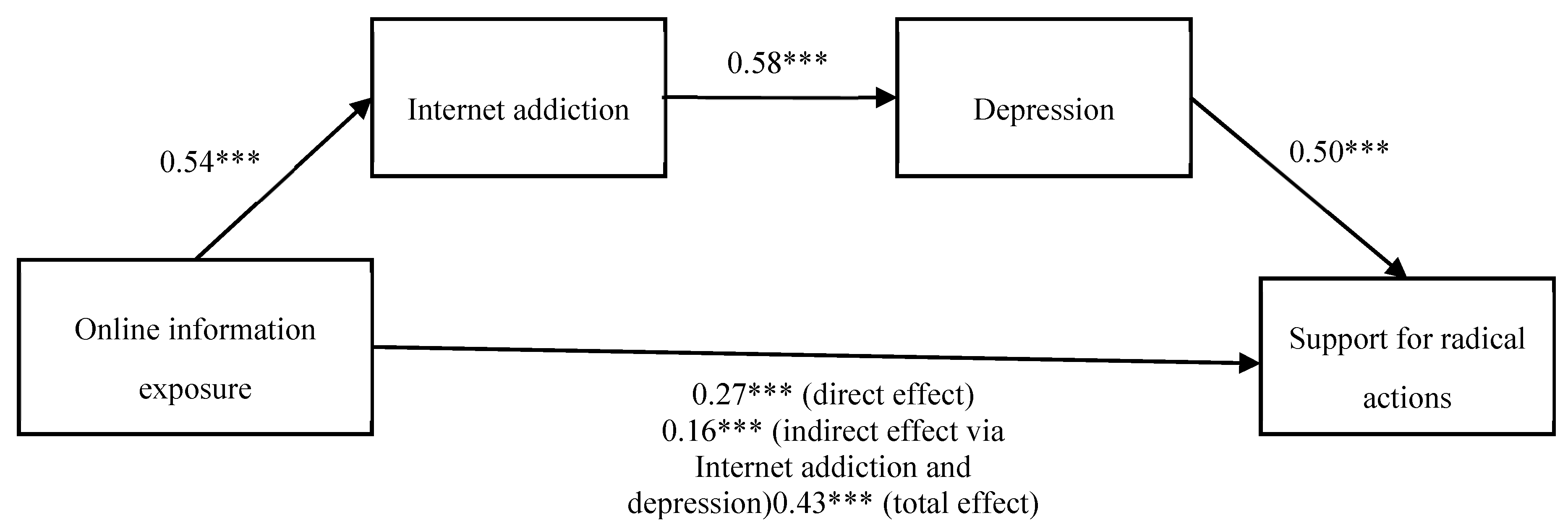Erratum: Tang, G., et al. Politically Motivated Internet Addiction: Relationships among Online Information Exposure, Internet Addiction, FOMO, Psychological Well-being, and Radicalism in Massive Political Turbulence. Int. J. Environ. Res. Public Health 2020, 17, 633
1. Addresses of Some of the Authors
Published version:
Corrected version:
2. Error in Formatting
Published version:
- H2:
- and H3 try to echo the relationship between online information exposure, Internet addiction, and psychological well-being that has been discussed in psychology. FOMO is also included as it is associated with Internet addiction [38] and it fits the movement context that is full of uncertainties and unexpected incidents. Psychological well-being includes depression and perceived social isolation as they are commonly observed as possible consequences of Internet addiction [29,31]. In the context of a movement, depression was found to be an emotional symptom during and after a protest [39,40], but its role is rarely discussed in social mobilization. In addition, perceived social isolation is not covered in the discussion about mobilization and yet, addictive Internet use can lead to a perception of whether some people are part of the majority or minority in a highly polarized atmosphere during a massive protest. The operationalization of the measurements was adjusted due to the context of massive protest in Hong Kong. This will be explained in the next section.
Corrected version:
Published version:
Corrected version:
3. Error in Decimal Places in Table 2
Published version:
| (1) | (2) | (3) | (4) | (5) | (6) | (7) | |
| 1. Attitudinal support for Anti-ELAB | -- | -- | -- | -- | -- | -- | -- |
| 2. Participation in Anti-ELAB | 0.55 *** | -- | -- | -- | -- | -- | -- |
| 3. Online information exposure | 0.51 *** | 0.40 *** | -- | -- | -- | -- | -- |
| 4. Internet addiction | 0.59 *** | 0.54 *** | 0.54 *** | -- | -- | -- | -- |
| 5. FOMO | 0.52 *** | 0.49 *** | 0.50 *** | 0.75 *** | -- | -- | -- |
| 6. Depression | 0.57 *** | 0.46 *** | 0.41 *** | 0.58 *** | 0.50 *** | -- | -- |
| 7. Perceived social isolation | −0.10 | 0.068 | 0.021 | 0.13 * | 0.15 * | 0.01 | -- |
| 8. Support for radical actions | 0.79 *** | 0.63 *** | 0.47 *** | 0.60 *** | 0.51 *** | 0.60 *** | −0.09 |
Corrected version:
| (1) | (2) | (3) | (4) | (5) | (6) | (7) | |
| 1. Attitudinal support for Anti-ELAB | -- | -- | -- | -- | -- | -- | -- |
| 2. Participation in Anti-ELAB | 0.55 *** | -- | -- | -- | -- | -- | -- |
| 3. Online information exposure | 0.51 *** | 0.40 *** | -- | -- | -- | -- | -- |
| 4. Internet addiction | 0.59 *** | 0.54 *** | 0.54 *** | -- | -- | -- | -- |
| 5. FOMO | 0.52 *** | 0.49 *** | 0.50 *** | 0.75 *** | -- | -- | -- |
| 6. Depression | 0.57 *** | 0.46 *** | 0.41 *** | 0.58 *** | 0.50 *** | -- | -- |
| 7. Perceived social isolation | −0.10 | 0.07 | 0.02 | 0.13 * | 0.15 * | 0.01 | -- |
| 8. Support for radical actions | 0.79 *** | 0.63 *** | 0.47 *** | 0.60 *** | 0.51 *** | 0.60 *** | −0.09 |
4. The Low Resolution of Figure 1
Published version:

Corrected version:

5. Other Typos
Published version:
Corrected version:
Published version:
Corrected version:
Published version:
Corrected version:
Published version:
Corrected version:
Published version:
Corrected version:
Published version:
Corrected version:
References
- Tang, G.; Hung, E.P.W.; Au-Yeung, H.-K.C.; Yuen, S. Politically Motivated Internet Addiction: Relationships among Online Information Exposure, Internet Addiction, FOMO, Psychological Well-being, and Radicalism in Massive Political Turbulence. Int. J. Environ. Res. Public Health 2020, 17, 17–633. [Google Scholar] [CrossRef] [PubMed]
© 2020 by the authors. Licensee MDPI, Basel, Switzerland. This article is an open access article distributed under the terms and conditions of the Creative Commons Attribution (CC BY) license (http://creativecommons.org/licenses/by/4.0/).
Share and Cite
Tang, G.; Hung, E.P.W.; Au-Yeung, H.-K.C.; Yuen, S. Erratum: Tang, G., et al. Politically Motivated Internet Addiction: Relationships among Online Information Exposure, Internet Addiction, FOMO, Psychological Well-being, and Radicalism in Massive Political Turbulence. Int. J. Environ. Res. Public Health 2020, 17, 633. Int. J. Environ. Res. Public Health 2020, 17, 2700. https://doi.org/10.3390/ijerph17082700
Tang G, Hung EPW, Au-Yeung H-KC, Yuen S. Erratum: Tang, G., et al. Politically Motivated Internet Addiction: Relationships among Online Information Exposure, Internet Addiction, FOMO, Psychological Well-being, and Radicalism in Massive Political Turbulence. Int. J. Environ. Res. Public Health 2020, 17, 633. International Journal of Environmental Research and Public Health. 2020; 17(8):2700. https://doi.org/10.3390/ijerph17082700
Chicago/Turabian StyleTang, Gary, Eva P. W. Hung, Ho-Kong Christopher Au-Yeung, and Samson Yuen. 2020. "Erratum: Tang, G., et al. Politically Motivated Internet Addiction: Relationships among Online Information Exposure, Internet Addiction, FOMO, Psychological Well-being, and Radicalism in Massive Political Turbulence. Int. J. Environ. Res. Public Health 2020, 17, 633" International Journal of Environmental Research and Public Health 17, no. 8: 2700. https://doi.org/10.3390/ijerph17082700
APA StyleTang, G., Hung, E. P. W., Au-Yeung, H.-K. C., & Yuen, S. (2020). Erratum: Tang, G., et al. Politically Motivated Internet Addiction: Relationships among Online Information Exposure, Internet Addiction, FOMO, Psychological Well-being, and Radicalism in Massive Political Turbulence. Int. J. Environ. Res. Public Health 2020, 17, 633. International Journal of Environmental Research and Public Health, 17(8), 2700. https://doi.org/10.3390/ijerph17082700





